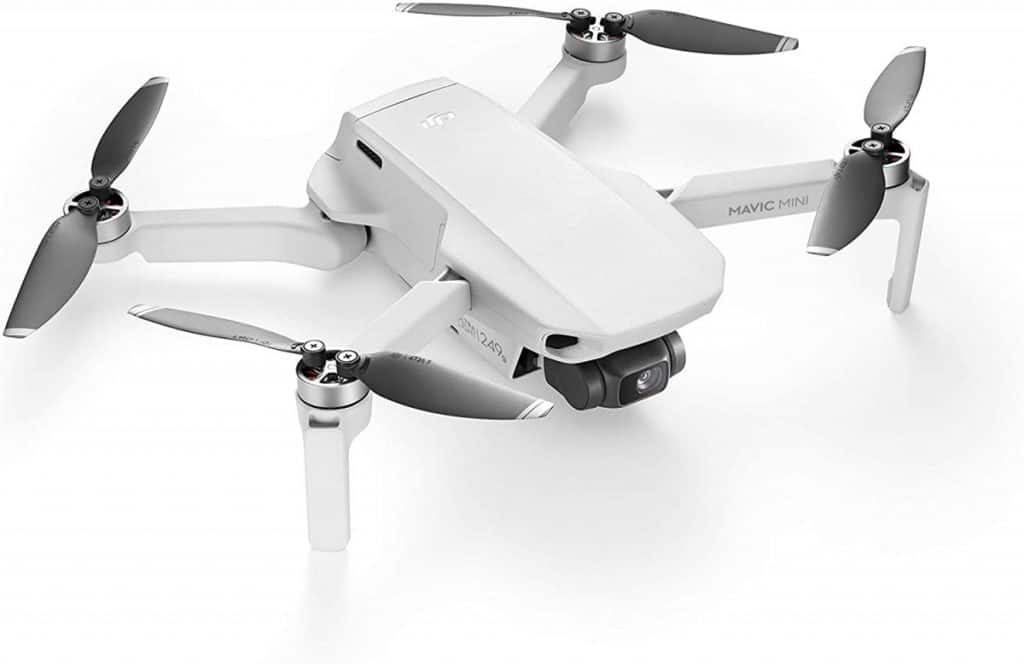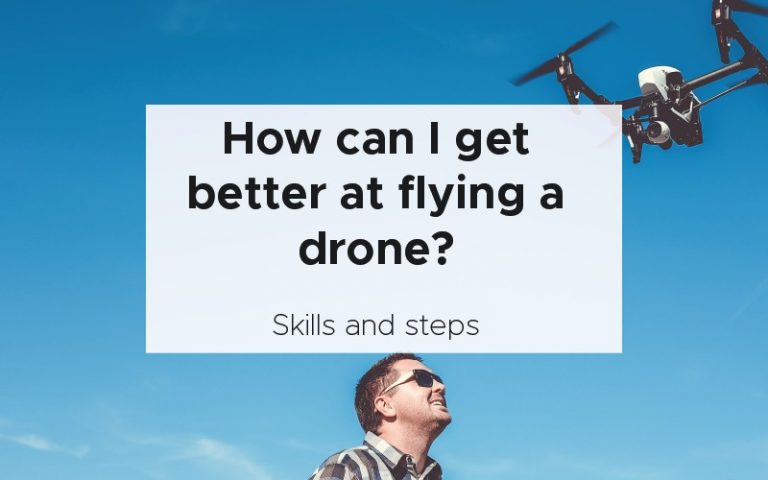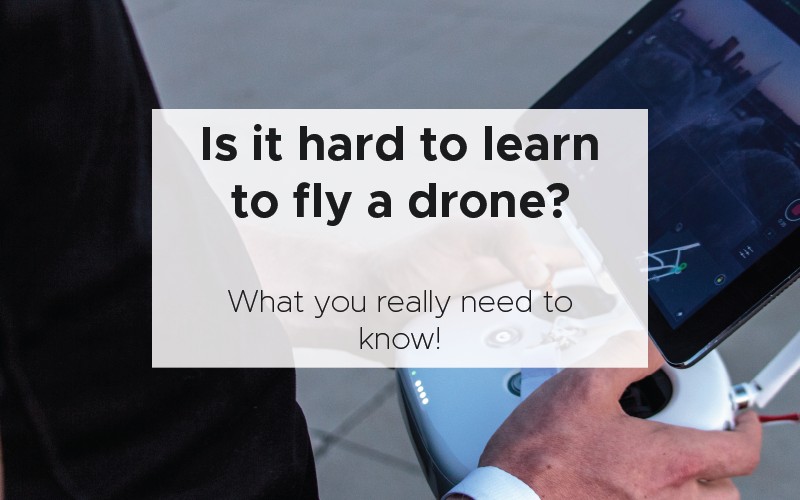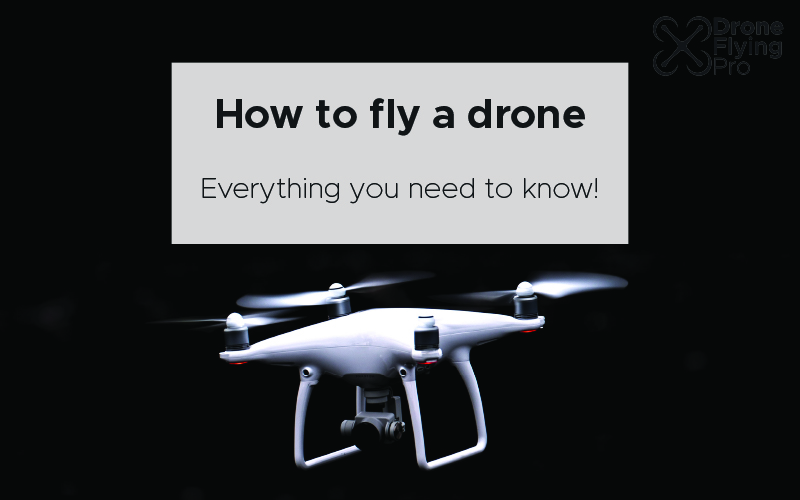When you first pick up a drone it is surprisingly easy to get started on flying. Modern day commercial drones have a range of sensors that make it easier than ever to get flying within minutes of receiving your drone. The issue is that after a while your flight experience and enjoyment correlates directly with how skilled you are with your drone. I have found that as I have been learning more techniques and practising the skills required to fly smoothly and safely the enjoyment of my flight has increased dramatically. Here, I will show you everything you need to know and be conscious of two get better at flying a drone. How can I get better at flying a drone? I will show you how – It’s simpler than you think.
Learning to fly a drone better comes down to practising all of the different skills required and pushing your zone of capability outwards so that even the hardest of manoeuvres become second nature. It’s just like riding a bike – all takes practice. You can practice by giving yourself a series of obstacles and flight patterns to manoeuvre through and flying in a variety of environmental conditions.
Let’s take a look at how easy it is to fly a drone and how you get better at doing it.
How easy is it to fly a drone?
Now we all love drone footage and watching a drone zip around the sky but how hard is it to achieve professional quality footage and expert level flying. You see, drone manufacturers want you to have the most fun possible while flying the drones. That means that they have embedded advanced artificial intelligence technology in their drones which means that you can fly one within minutes of opening the box. Drones will auto hover, auto stabilise, return to home, and avoid obstacles during their flights. However, you can also turn off all of these advanced features and enter “sports mode” which will push your drone flying skills to their limits. I often joke that flying a drone is like playing chess – you can learn it in just a few minutes (on YouTube or with a friend) but it takes a lifetime to master and become a professional drone flyer.
If you want to know more about how hard it is to learn to fly a drone check out my other article – is it hard to learn to fly a drone? [The ultimate guide] – click here.
How long does it take to learn to fly a drone?
Now this question depends on a load of factors. This depends on you, your skills, and experience that you bring to flying a drone. One flight instructor told me that some students are ready to fly alone within minutes while other people require many hours of practice with a professional instructor to hone their skills. DJI Mavic series drones have such a high level of automation and are constantly sensing their environment and so they will keep your drone very safe as long as you don’t do anything too stupid.
The cheaper the drone the more difficult it is to fly in a controllable and stable way. The cheapest of toy drones are so difficult to fly that they will crash regularly even if you are a drone flying expert. The reason you pay more money for a drone is to get access to sensors, technology, and artificial intelligence that will make your flight enjoyable. However, all of these advanced technologies are not an absolute failsafe for people who want to be reckless with their drones.
Start with a beginner drone
A beginner drone is one that does not cost too much money (so you are not super concerned about crashing it all the time) but also has some of the nicer drone flying features such as auto hovering, auto stabilisation, a good camera – so you can show off your flights, and is from a reputable manufacturer.
For most people I recommend getting the Mavic mini. The DJI Mavic mini is one of the most impressive drones for its size and it has so many different features that you will be up and running within a matter of minutes. Here are some of the features that I absolutely love about it:
- 30 minutes of flight time – when you are trying to learn to get better at flying a drone flight time really matters. If you have a couple of batteries on hand this drone will easily give you one hour of flight time. Each battery lasts about 30 minutes. That means you can get the most out of each drone flying trip that you take.
- Inexpensive – you can spend thousands of dollars on a drone that will not bring you any more joy or ability to practice your flight. The great thing about the DJI Mavic mini is that you are able to get access to drone practice at a fraction of the cost of the larger drones.
- DJI advanced flying features – if you are wanting to get better at flying a drone you want to practice so that you can use the skills you learn on bigger and more expensive drones. The DJI Mavic mini allows you to get used to the DJI ecosystem of apps and features.
- Small and light – some of the more expensive drones can be a little bit of a pain to carry around. In the early days of learning to fly you don’t need any excuses for not taking your drone out and about with you. The DJI Mavic mini is one of the smallest drones that you can pack in your suitcase, pack, or day bag – so you never have an excuse not to take it with you.
DJI Mavic mini

Pros
+ 30 min Max. Flight Time
+ Under 250 g
+ Smart features of much more expensive drones
Cons
~ No 4K – understandable at this price point
~ Effected by strong winds
~ No avoidance sensors
Once you have mastered the skills that I will list below on this beginner drone it will make flying a much more expensive drone more comfortable and enjoyable for you.
How to practice flying a drone
If you are asking yourself “how can I get better at flying a drone?” There is only really one answer after actually buying a drone – get out there and fly it as often as possible. Learning a new skill requires you to practice for about 10,000 hours to go from complete beginner to master. However, you probably only need about 20 hours of flight time to go from beginner to confident drone flyer. There is a great Ted X talk from Josh Kaufman who tells you how to learn anything in the first 20 hours. Here is a link to the YouTube video if you want to get some inspiration or learning how to flyer drone better.
Here are the steps in the four techniques that you will need to perfect if you are going to level up your drone flying skills.
Deconstruct what you actually want to achieve
When you look at good drone flyers it can become pretty overwhelming with all of the stuff that they are doing. The first thing you need to do is deconstruct the skill of flying a drone and break it down into smaller and smaller pieces. Most of the things we think of as skills are actually a big bundle of skills that combine to do something awesome. The more you can break down your drone flying practice the faster you will be able to improve your skills.
Self correct
This is probably one of the most confusing aspects of learning a new skill – especially as a new drone pilot. The first thing to do is get your base level knowledge to a point where you know that you are doing something wrong. You can learn that from books, YouTube, online courses or whatever other resource you have at hand.
Learning to flyer drone becomes easier when you can just identify that you have made a mistake so that you can do something about it and do something different to correct that mistake in the future.
Join a community of drone flyers
By joining a community of people who fly drones regularly you will be learning from people who have been there and done that. It’s also a good idea to consider learning to fly a drone with another beginner. I have found that the combination of flying with seasoned professionals and then teaching another beginner is the perfect way to solidify any learnings from more experienced flyers.
There are plenty of places where you can join a community of drone flyers and you can find a lot of them on meetup.com.
Not only does joining a community mean that you learn new skills but you will find new friends and companionship through a common interest. I know that I have made some of my best friends by joining groups where we have shared interests and hobbies.
Take breaks
When you are learning something new there is a three-step process that I find is the most beneficial for retaining the knowledge that I have ingested. Firstly, it is important that I read a lot about the subject that I want to know more about. Then I need to put that straight into practice. Whether that is getting out with my drone or using a drone simulator I need to be able to see exactly what I have learnt being put into action. Then the last step is to let my brain reorganise all of that information.
The way to do that most effectively, in my experience, is to take a break.
By taking breaks you give your mind the ability to digests and contemplate the information you have just absorbed subconsciously. I know that I have got the best results from not thinking about a subject for a day and then revisiting it later. So, never be afraid of taking breaks when you need it – like when you are experiencing mental fatigue – let your brain saw out the information that it has already gained.
If you follow these steps I’m in no doubt that you will be able to learn how to become a better drone flyer in an efficient and enjoyable way. Now, let’s take a look at the specific skills that you can use to get better at flying a drone.
Specific skills so that you can learn to get better at flying a drone
These skills may help you when you are deconstructing the skill of flying a drone so that you can learn it more efficiently.
Practice flying towards yourself
if your drone isn’t equipped with headless mode (where the controls are agnostic to the direction of the drone) you should spend some time practising flying towards yourself. As you are flying towards yourself the left and right controls are reversed which means that if you are not using the first person view of your controller it can be very confusing initially.
You should do this as often as you need to so that it becomes second nature for when you are doing the return trip of your flight. One of the easiest ways to practice this is to head out and away from you turn around and then do a zigzag path back towards yourself. You can check the flight GPS location to make sure that you are travelling towards yourself while also moving side to side in a reproducible and controllable way. One of the great reasons to practice this skill is so that you can get some awesome selfie shots and “dronie shots” so that you can show off your skills online.
Get yourself in loads of flying conditions
When you are going out and flying a drone no two days are the same. Some days it will be windy, some days it will be dry, some days it will be very sunny, some days it will be gusty, and some days it will be drizzly and rainy – all of these are chances for you to gain experience in a load of different environmental and flying conditions.
You will also have to practice the art of learning when not to fly your drone for fear of hurting the drone or people (including yourself). When you first start flying a drone I would recommend only flying in moderate conditions. Then, as you get more comfortable flying the drone in good conditions, you can start flying a drone in more and more challenging situations such as high winds.
A typical rule of thumb is that you should not fly your drone if the wind speeds are higher than two thirds of your drone’s maximum velocity. Also, you should probably never fly in heavy rain or consistent drizzle. If the electronics on your drone get wet and short-circuit there is very little you can do to get your drone back to a working condition.
Fly in a square and figure of 8
One of the best things you can do for your drone flying skills is learning to fly in a specific and reproducible pattern. This includes flying in a square, circle, straight-line and in a figure 8. Each of these different shapes require you to expertly manipulate the different functions of drone thrust. This includes:
- yaw – yaw is the control that rotates your drone clockwise or counterclockwise around it centrepoint. It doesn’t move forward or backward when you use your left stick but instead it should remain stationary when performing this movement.
- Throttle – this refers to how much power is supplied to the motors and will increase the height of the drone.
- Pitch – this moves the nose of the drone upwards or downwards causing the drone to move forward and backward
- roll – this is like pitch but moves each side of the drone up or down causing the drone to move side to side.
Getting to grips with how the drone responds to each stick and the combination of movements is the only way to really get better at flying a drone in a reproducible and specific way. Do these movements while looking through first person view on your controller and by looking at the drone as it flies through the sky.
Use a flight simulator
Sometimes you can just feel like you need some simple training before you are comfortable enough taking it out into the wild! It’s also a great way to see if drone flying is for you without spending a dime on a drone! Quadcopters and drones can be really expensive so a little bit of training you save you from the heartache of a big crash!
Here are the top flight simulators that you can buy (the DJI simulator even has a free option).
- DJI Drones simulator – Free, Enterprise, and Energy versions available. It has different training modules that support nearly every drone that they have manufactured.
- DroneSimPro – $29.99 for Mac and Windows.
- Real Flight RF8 – $188 for windows
- Phoenix R/C – 139 for windows
Some of the above drone simulators offer the ability to link up with a controller so you get a real world flying experience. These drone simulators can test your flying, with real physics emulation. in a number of different flying conditions. These are all a great way for beginners to practice and also for seasoned flyers to get some virtual flight hours under their belts so that hey an execute even better when they next head out for a flight!
Go through all of the automated flying functions
The DJI series drones also have a load of advanced features that give you confidence while flying the drone and allows you to focus on getting the shot!
Sports mode
Sports or turbo mode is found on some drones. This allows the pilot to move quicker and more agile through the air and turns off obstacle avoidance. It probably best not to turn this on if you are a beginner drone pilot.
This mode will also make the drone much more reactive but at a cost to the flight time as the movements will be more aggressive and therefore require more power.
Return to home
I have never used return to home but I’m so glad that it is there if I ever need it. Return to home brings back the drone to either where it took off from or it will return to where the remote is currently located. It’s a safety feature that makes me extra confident when flying in unknown for difficult conditions.
I have set my return to home flight height to 55 meters and have never had any issue with the drone needing to avoid any trees or other obstacles at that height while returning home.
Pause buttons
Some of the more advanced camera drones have automatic capturing modes. This is where the drone will fly a certain pattern while keeping the subject of the shot in the frame. This is great for people that want to grab a quick drone shot for social media or other online purpose.
The pause button stops the drone in it’s tracks as soon as you push it. It could be that you have noticed that the drone is approaching a hazard or the conditions have changed quickly and you risk hurting the drone or someone/thing else. Having a pause button when the drone is performing automatic flying patters is another confidence builder!
Now that you know the most important parts of a drone controller we now need to do our simple preflight checks to make sure the drone and the conditions are OK for your planned flight.
practice practice practice
Lastly, you need to make sure that you make time to practice as much as possible. If you need more information on how to fly a drone check out my other article – how to fly a drone – click here.
Conclusion
When you are learning to fly a drone and trying to get better the one thing that you need to do is fly as much as possible. But just flying without a goal will not allow you to get better. So to learn this new skill you must:
- deconstruct skill – deconstruct the skill so that you break it up into manageable bite-size chunks that will combine to give you an awesome skill.
- Get out and practice this skill – about 20 hours of practising a single skill will get you to the point where you can call yourself an intermediate drone flyer.
- Teach other people – one of the best things for me to remember the skills I’ve learned is to teach other people how to do the same thing.
Remember, that this is a journey and you need to be patient with yourself as you are learning. It can be very tempting to want to rush ahead and learn everything at once but taking a stepwise approach and motivated by completing these individual steps you will become a much better drone flyer. Happy drone flying my beautiful friends and make sure that your drone journey is a productive one.






